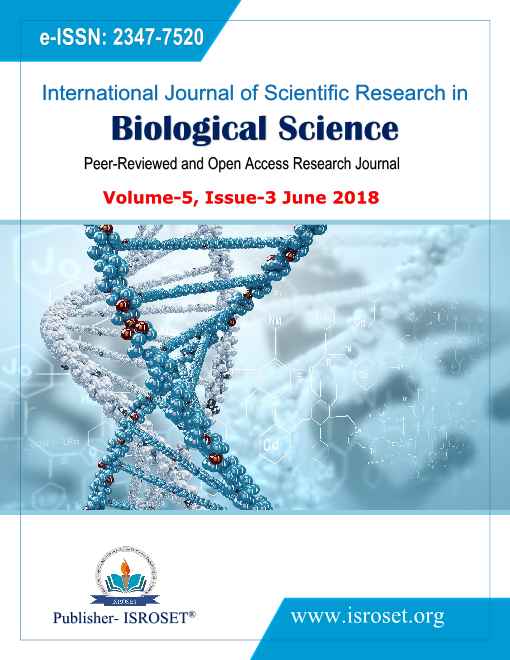Optimization and Characterization of Xylanase from An Indigenous Strain of Aureobasidium Pullulans
Keywords:
Xylanase, Aurobasidium pullulans, optimization, characterizationAbstract
Xylanases are versatile hydrolytic enzymes in nature, due to its degradatory properties and ability to degrade hemicelluloses efficiently. Xylanases and associated debranching enzymes produced by a variety of microorganisms including bacteria, actinomycetes, yeast and fungi bring hydrolysis of hemicelluloses. Among microorganisms, filamentous fungi are the predominant source organism for xylanases. Xylanases have fortified awesome interest because of their potential application in a many industries. Throughout the years, the quantity of conceivable uses of xylanases in the paper and pulp industry has expanded relentlessly, and a few applications have been popularized. In present investigation an indigenous species of Aureobasidium pullulans was evaluated for xylanse producing efficiency and various parameters affecting the production was standardized employing one-factor at a time approach. This resulted in significant enhancement of enzyme activity from 8.7 U/ml to 27.75 U/ml. The enzyme optima for pH and temperature were found to be 6 and 55 °C respectively.
References
A.D. Harris, C. Ramalingam, "Xylanases and its application in food industry: a review", Journal of Experimental Science, Vol.1, pp.1-11, 2010.
E. X. F. Filho, J. Puls, M. P. Coughlan, "Biochemical characteristics of two endo-β-1,4-xylanases produced by Penicillium capsulatum", Journal of Industrial Microbiology, Vol.11,Issue 3,pp. 171-180, 1992.
R. C. Kuhad, A. Singh, "Lignocellulose Biotechnology: Current and Future Prospects", Critical Reviews in Biotechnology, Vol.13, pp.151–172, 1993.
F. Niehaus, C. Bertoldo, M. Kähler, G. Antranikian, "Extremophiles as a source of novel enzymes for industrial application, Applied Microbiology and Biotechnology, Vol.51, pp.711–729, 1999.
D. M. Otero, C. L. Cadaval, L. M. Teixeira, C. A. Rosa, A. V. L. Sanzo, S. J. Kalil, "Screening of yeasts capable of producing cellulase-free xylanase", African Journal of Biotechnology, Vol.14, pp.1961–1969, 2015.
P. Biely, "Microbial xylanolytic Systems", Trends in Biotechnology, Vol.3, pp. 286–290, 1985.
M.L.T.M. Polizeli, A.C.S. Rizzatti, R. Monti, H.F. Terenzi, J.A. Jorge, D.S. Amorim, "Xylanases from fungi: properties and industrial applications", Applied Microbiology and Biotechnology, Vol.67, pp.577–591, 2005.
J. Alvarez-Cervantes, E. M. Domínguez-Hernández, Y. Mercado-Flores, A. O’Donovan, G. Díaz-Godínez, "Mycosphere essay 10: properties and characteristics of microbial xylanases", Mycosphere, Vol.87, pp.11-24, 2016.
A. Walia, S. Guleria, P. Mehta, "Microbial xylanases and their industrial application in pulp and paper biobleaching: a review", 3 Biotech, Vol.7, pp.11, 2017.
G. S. Hoog de, "Evolution of black yeasts: possible adaptation to the human host", Antonie van Leeuwenhoek, Vol.63, pp.105–109, 1993.
Z. Chi, F. Wang, Z. Chi, L. Yue, G. Liu, T. Zhang, "Bioproducts from Aureobasidium pullulans, biotechnologically important yeast", Applied Microbiology and Biotechnology, Vol.82, pp. 793-804, 2009.
M. J. Bailey, J. Buchert, L. Viikari, "Effect of pH on production of xylanase by Trichoderma reesei on xylan and cellulose-based media", Applied Microbiology and Biotechnology, Vol.40, pp.224-229, 1993.
S. Kar, A. Mandal, P. K. Mohapatra, K. C. Mondal, B. R. Pati, "Production of cellulase-free xylanase by Trichoderma reesei SAF3", Brazilian Journal of Microbiology, Vol.37, pp.462–464, 2006.
S. G. Nair, R. Sindhu, S. Shankar, "Purification and biochemical characterization of two xylanases from Aspergillus sydowii SBS 45", Applied Biochemistry and Biotechnology, Vol.149, pp.229–243, 2008.
F. Bravery, "Microbiological breakdown of cellulose in the presence of alternative carbon sources", Journal of the Science of Food and Agriulture, Vol.19, pp.133-135, 1968.
W. B. Jakoby, "Crystallization as a purification technique", Methods in Enzymology, Vol.22, pp.248–252, 1971.
S. Nasr, M. R. Soudi, A. F. Salmanian, P. Ghadam, "Partial optimization of endo-1, 4-β-xylanase production by Aureobasidium pullulans using agro-industrial residues", Iranian Journal of Basic Medical Sciences, Vol.16, pp.1245-1253, 2013.
J. Myburgh, B. A. Prior, S. G. Kilian, "Production of xylan-hydrolyzing enzymes by Aureobasidium pullulans", Journal of Fermentation and Bioengineering, Vol.72, pp.135-137, 1991.
S. Yegin, " Xylanase production by Aureobasidium pullulans on globe artichoke stem: bioprocess optimization, enzyme characterization, and application in saccharification of lignocellulosic biomass", Preparative Biochemistry and Biotechnology, Vol.47, pp.441-449, 2016.
Priem, J. Dobberstein, C.C. Emis C, "Production of β-1,4 xylanase in continous culture by aureobasium pullulans CBS 58475", Biotechnology Letters, Vol.13, pp.149-154, 1991.
C. Smith, T. M. Wood, "Xylanase production by Aspergillus awamori: Development of a medium and optimization of the fermentation parameters for the production of extracellular xylanase and α- xylosidase while maintaining low protease production", Biotechnology and Bioengineering, Vol.38, pp.880- 890, 1991.
T. D. Leathers, "Purification and properties of xylanase from Aureobasidium", Journal of Industrial Microbiology, Vol.4, pp.341-358, 1988.
K. Ohta, S. Moriyama, H. Tanaka, T. Shige, H. Akimoto, " Purification and characterization of an acidophilic xylanase from Aureobasidium pullulans and sequence analysis of the encoding genes", Journal of Bioscience and Bioengineering, Vol.92, pp.262-270, 2001
J. F. Riordan, "The role of metals in enzyme activity", Annals of Clinical and Laboratory Science, Vol.7, pp. 119-129, 1977.
Downloads
Published
How to Cite
Issue
Section
License

This work is licensed under a Creative Commons Attribution 4.0 International License.
Authors contributing to this journal agree to publish their articles under the Creative Commons Attribution 4.0 International License, allowing third parties to share their work (copy, distribute, transmit) and to adapt it, under the condition that the authors are given credit and that in the event of reuse or distribution, the terms of this license are made clear.







